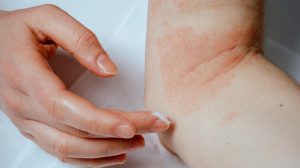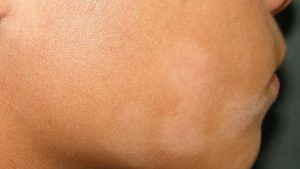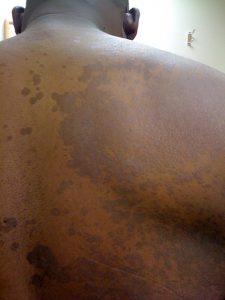Are you one of those people that think every light/hypopigmented patch on your face is caused by eczema? Don’t worry, you are not alone. I used to be like that.

Patient with eczema (Image source: Gettyimage)
What is Eczema?
Eczema is a skin condition. It presents as itchy, dry, reddish (more evident if you have a fair complexion) scaly skin lesions. It is typically seen on the hands, feet, back of the knee, and the arms,

A boy with pityriasis alba. Image Credit: Very well health
Pityriasis alba
A light patch is a skin discolouration (absence of pigment). Pityriasis alba presents as a pale, round, scaly patch, with indistinct edges. It can be seen on different body parts. It is asymptomatic, often goes away on its own but can also be treated, especially if it’s itchy. A moisturizing cream helps with the look of the patch.

A Man with Tinea vesicolor. (Image credit- Wiley Online Library)
- Cutaneous Yeast Infection
Medically, it is called tinea versicolor or pityriasis versicolor.
Tinea versicolor happens when the yeast resident in the skin grows beyond normal. Those areas usually appear lighter (hypopigmented) than other parts. It occurs more commonly in humid regions. It can be treated with antifungal medications.
The affected area of skin is permanently hypopigmented. This is caused by the destruction of cells responsible for melanin production which gives the skin its colour. Most times, vitiligo is initially observed on an individual’s skin in his/her 20s. Chances of this condition increase for individuals who have a family history.
There is no confirmed cause for vitiligo. Also, treatment is a little complicated. Read more about it here.
Bottom-line
Generally, white patches on your face (or other body parts) shouldn’t bother you so much. Just make sure you are treating your skin right. This includes hygiene, nutrition, skin products usage, and so on. If the patches remain after a few weeks, then see your doctor!

A phenomenal lady whose skills and style do the talking. Her unending desire for better healthcare from persons, through to the public has always been her drive. Over the years, she has volunteered with different NGOs that try to promote a healthy lifestyle.
She hopes to one day create an avenue for people to get the guidance needed for nutrition essential for life, amongst other things. She believes knowledge paves ways. And so, makes it a responsibility to keep learning and impacting others.
Deborah Solomon is a believer and currently a medical student at the Obafemi Awolowo University, Nigeria. She enjoys writing, traveling, music, and cooking.

